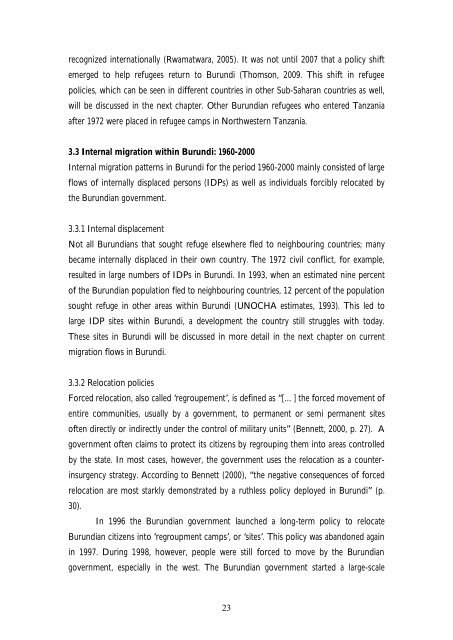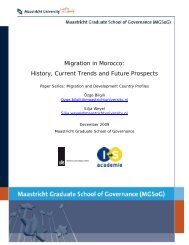Migration in Burundi: History, Current Trends and Future - MGSoG ...
Migration in Burundi: History, Current Trends and Future - MGSoG ...
Migration in Burundi: History, Current Trends and Future - MGSoG ...
Create successful ePaper yourself
Turn your PDF publications into a flip-book with our unique Google optimized e-Paper software.
ecognized <strong>in</strong>ternationally (Rwamatwara, 2005). It was not until 2007 that a policy shift<br />
emerged to help refugees return to <strong>Burundi</strong> (Thomson, 2009. This shift <strong>in</strong> refugee<br />
policies, which can be seen <strong>in</strong> different countries <strong>in</strong> other Sub-Saharan countries as well,<br />
will be discussed <strong>in</strong> the next chapter. Other <strong>Burundi</strong>an refugees who entered Tanzania<br />
after 1972 were placed <strong>in</strong> refugee camps <strong>in</strong> Northwestern Tanzania.<br />
3.3 Internal migration with<strong>in</strong> <strong>Burundi</strong>: 1960-2000<br />
Internal migration patterns <strong>in</strong> <strong>Burundi</strong> for the period 1960-2000 ma<strong>in</strong>ly consisted of large<br />
flows of <strong>in</strong>ternally displaced persons (IDPs) as well as <strong>in</strong>dividuals forcibly relocated by<br />
the <strong>Burundi</strong>an government.<br />
3.3.1 Internal displacement<br />
Not all <strong>Burundi</strong>ans that sought refuge elsewhere fled to neighbour<strong>in</strong>g countries; many<br />
became <strong>in</strong>ternally displaced <strong>in</strong> their own country. The 1972 civil conflict, for example,<br />
resulted <strong>in</strong> large numbers of IDPs <strong>in</strong> <strong>Burundi</strong>. In 1993, when an estimated n<strong>in</strong>e percent<br />
of the <strong>Burundi</strong>an population fled to neighbour<strong>in</strong>g countries, 12 percent of the population<br />
sought refuge <strong>in</strong> other areas with<strong>in</strong> <strong>Burundi</strong> (UNOCHA estimates, 1993). This led to<br />
large IDP sites with<strong>in</strong> <strong>Burundi</strong>, a development the country still struggles with today.<br />
These sites <strong>in</strong> <strong>Burundi</strong> will be discussed <strong>in</strong> more detail <strong>in</strong> the next chapter on current<br />
migration flows <strong>in</strong> <strong>Burundi</strong>.<br />
3.3.2 Relocation policies<br />
Forced relocation, also called ‘regroupement’, is def<strong>in</strong>ed as “[… ] the forced movement of<br />
entire communities, usually by a government, to permanent or semi permanent sites<br />
often directly or <strong>in</strong>directly under the control of military units” (Bennett, 2000, p. 27). A<br />
government often claims to protect its citizens by regroup<strong>in</strong>g them <strong>in</strong>to areas controlled<br />
by the state. In most cases, however, the government uses the relocation as a counter-<br />
<strong>in</strong>surgency strategy. Accord<strong>in</strong>g to Bennett (2000), “the negative consequences of forced<br />
relocation are most starkly demonstrated by a ruthless policy deployed <strong>in</strong> <strong>Burundi</strong>” (p.<br />
30).<br />
In 1996 the <strong>Burundi</strong>an government launched a long-term policy to relocate<br />
<strong>Burundi</strong>an citizens <strong>in</strong>to ‘regroupment camps’, or ‘sites’. This policy was ab<strong>and</strong>oned aga<strong>in</strong><br />
<strong>in</strong> 1997. Dur<strong>in</strong>g 1998, however, people were still forced to move by the <strong>Burundi</strong>an<br />
government, especially <strong>in</strong> the west. The <strong>Burundi</strong>an government started a large-scale<br />
23



